by Tom Gaylord
Writing as B.B. Pelletier
This report covers:
- Target-grade peep sights
- Different peep sights
- FWB 300S peep
- Walther peep
- AirForce Peep
- East German Haenel 311 sight
- Not much change
- What about sloppy peeps?
- The “GAMO” peep
- Daisy plastic peep
- Summary
Today I get to play a little. One of the reasons I wrote this report that is turning into a series was to talk about target-grade peep sights. I didn’t do that in Part 1, so today is my day.
Target-grade peep sights
The first target-grade peep sight I saw was on the Winchester model 52 target rifle on which I learned to shoot. I was impressed by what could be done with such a sight. The first airgun target peep sight I saw was probably on an Anschütz 250 target rifle I once owned. It was large and had crisp adjustment knobs to move the peephole where I wanted. The size of the sight was impressive and I think I equated that size to precision. It was precise, but not for the reason I thought.
To be precise a peep sight needs two things. The first is a rock-solid platform that moves in two directions — and ONLY two directions. One is up/down and the other is left/right. Good sporting peeps also have that, so what more do target sights need?
The other thing they need is a very fine fine thread on each adjustment screw. A sporting peep tries to accommodate a wide range of adjustments for elevation. That way it can support a larger (higher) trajectory than would be needed for a rifle shooting known ammunition at a known distance. The target peep only needs a narrow range of elevation adjustment, because the distance is always the same — 10 meters for air rifles and 50 feet for smallbore rimfire target rifles. And the velocity of the round is also kept within a narrow range of numbers — 550-650 f.p.s. for 10-meter rifles and 1,000-1,050 f.p.,s. for rimfires. That keeps the possible height of the projectile’s arc constrained.
That is the reason it is so difficult to sight in a precision target air rifle at a distance of, say, 50 yards. Take a Feinwerkbau 300S, for example. It was designed to shoot at 10 meters, which is 33 feet. It has a known muzzle velocity of 610 to 650 f.p.s., when shot with the pellets for which it was designed. But you want to shoot it out to 150 feet and you wonder why it prints so low on the target paper. You are shooting more than 4.5 times farther than the rifle was designed to shoot and its makers made the rear sight adjustable within a narrow range at 33 feet to accommodate different types of ammunition.
Target shooters are the people for whom the rifle was designed and they are concerned with moving the strike of a pellet by a quarter the diameter of a pellet. Since the 300S was deigned to shoot .177 pellets, only, that’s a move of just 0.04425-inches or 1.124-mm. But you are wanting to move the elevation up by 11.5-inches at 50 yards! That’s not going to work, is it?
Yes things can be done to correct this, but that’s not the subject of today’s report. We are looking at peep sights the way they were designed.
Different peep sights
Let’s look now at several different target-grade peep sights, to see how they compare. Most of these will be vintage sights, but I will address that after we look at them.
FWB 300S peep
I’m going to show just one FWB peep sight, but FWB changed this sight many times over the years that the models 110, 150 and 300 target rifles were in existence. So, the next one you see may differ a little or a lot from this one, depending on when it was made.
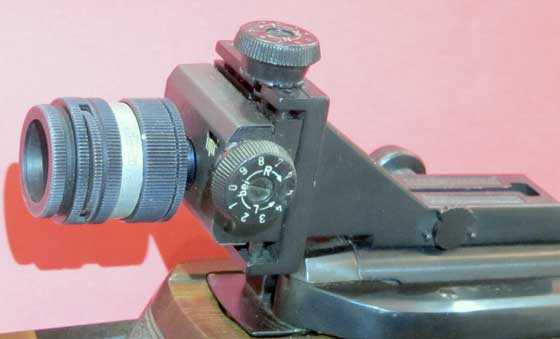
The peep sight on my FWB 300s has a Gehmann filter set on the back to change the colors seen by the shooter. It also changes the size of the peephole. With that device the shooter can adjust to the lighting conditions at any target range.
The FWB 300 peep moves a block that contains the peephole in both directions. There are actually two blocks that are held together by a long dovetail. That way the sight can control the amount of slop when changing adjustment directions to almost zero. Spring-loaded detents that are controlled by tiny ball bearings work with this arrangement to keep the slop to a minimum. I will discuss slop in peep sights at the end of the report.
Walther peep
The Walther peep I will show is from the same timeframe as the FWB. Walther established a good design and then kept on producing it for decades as target rifles came and went. This one is probably from the late 1960s, but it looks very similar to the same sight made in the 1950s and ’70s.
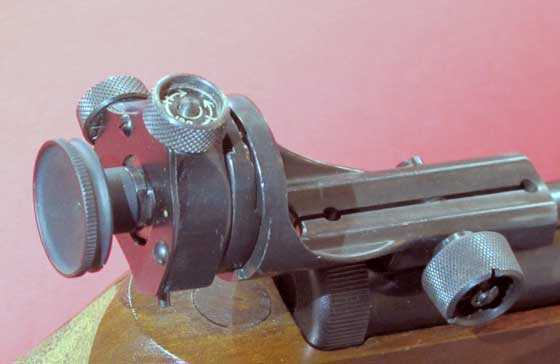
Walther’s high-grade target peep uses the same two sliding blocks as FWB, only Walther’s overall look is circular instead of square. Walther also put the windage adjustment knob on the left side of the unit, while FWB put it on the right. The eyepieces are interchangeable and accept other devices like the Gehmann unit seen above.
Everybody wants their peep sight to be unique, so they can tout it as the best. But they also cannot afford to not accept the popular accessories like the Gehmann units shown above. So the peepholes tend to have threads that are common across most competing brands.
Everybody also needs their sight to accept the rubber eyeshade that nearly all top competitors use. So the outside diameter of the peep disk also has to be pretty common.
AirForce Peep
Now, AirForce airguns makes both a rear peep and a front globe that accepts interchangeable inserts. These are both made for the Edge target rifle. I was not with the company when the Edge was designed, but I did help them with the final pre-production shakedown. I was flabbergasted when I discovered that AirForce had designed and then produced a world-class peep sight all on their own!
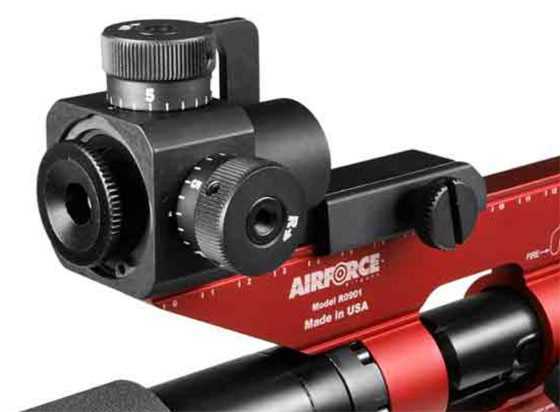
The AirForce peep is made for the Edge youth target rifle, but it is fully the equal of other world-class peeps.
In fact, I was so impressed by the AirForce peep that when it came out I told all of you that it was as good as any other world-class peep for about $100 less. Today the separation in price is even larger! I will put it up against a $600 FWB peep sight and expect similar performance. That’s a $458 separation! Now, I’m not telling you to put one on your $3,000 FWB 800X target rifle. What I’m telling you is you can stop looking for an FWB replacement sight on Ebay for your own target rifle, because the AirForce sight has you covered.
The AirForce sight is modern, which means they got away from making those expensive-to-machine sliding dovetail casement parts — JUST LIKE FEINWERKBAU DID! But AirForce went one step farther. They put the entire adjustable sight assembly — the one that adjusts in tiny increments — on a sliding vertical post. If you have one of these you really can adjust that FWB 300S to shoot at 50 yards! The $600 FWB peep doesn’t even have that function today.
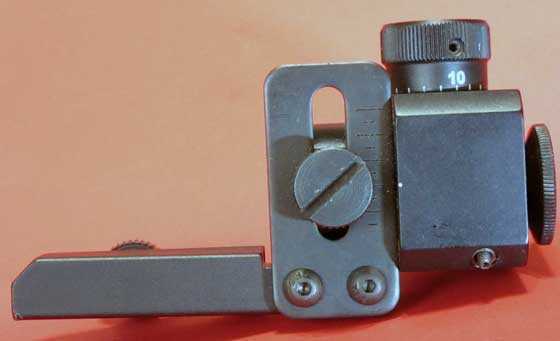
The entire unit can slide up or down on that post.
East German Haenel 311 sight
Okay, we have looked at world-class peep sights today. Where does the one on the Haenel 311 “target rifle” fit in? Well, in my opinion, this is an instance where the sight is more capable than the rifle it’s mounted on. The sight is fully up to world-class standards as far as adjustment is concerned. Maybe it looks a little odd to unaccustomed eyes, but the adjustments are as precise as those on a Walther or Anschütz sight
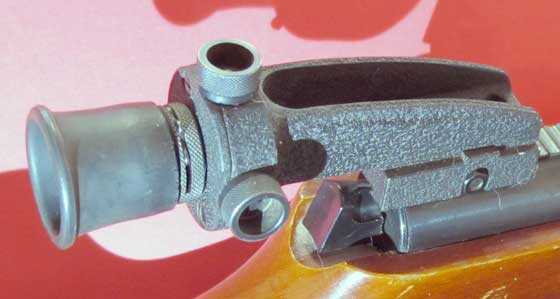
I see some similarity between the Haenel peep sight and the one from Walther. I left the rubber eyecup on because it has hardened and I am afraid of splitting it if I try to remove it.
The Haenel 311 rifle that this sight is mounted on is a taploader that works via a bolt action. As far as accuracy at 10 meters goes it is a junior class target rifle at its best, and probably not even that, but the sight can hold its own on any target rifle. Being built in a Communist regime, the designers used what was available, not necessarily what was best-suited to the rifle.
Not much change
We have looked at high-grade peep sights but, except for the AirForce peep, they are all vintage. You need to know that nothing much has changed in peeps since these sights were made and used. Modern peep sights look different but they have all the same basic functions are what we have seen today. Front sights have changed a lot over the years, but not rear sights.
What about sloppy peeps?
Are there “sloppy” peep sights? Yes, there are.
Do they even work? Yes, they can work perfectly. And some sights you may think are sloppy really aren’t.
The “GAMO” peep
First of all, Gamo probably never made this peep sight. If they did, the Chinese knocked it off and began producing it for cheap many years ago.
I really don’t know if Gamo ever produced the peep sight that carries their name, but regardless of who did, how does it stack up? Well, I can see some cost-cutting measures, but they aren’t necessarily bad ones. Think of them as an advance in how a peep sight can be made, rather than doing things on the cheap. In my experience the “Gamo” peep sight is very good and precise. I put the quotes around the name Gamo because a lot of airgunners still refer to this sight by that name, regardless of where it came from.
For years after the Gamo 126 target rifle stopped being made, Gamo was still selling this peep sight. Somewhere along the way the Gamo name slid off the sight and you now find it in many places — sold under many names. The rear sight on the Crosman Challenger PCP is one place you’ll see it and the Air Venturi target sight is another. Gamo and Daisy did a lot of business together before Gamo bought the Daisy company outright, so you will see the Gamo peep offered on some Daisy target rifles as an upgrade, and it is standard on the 753.
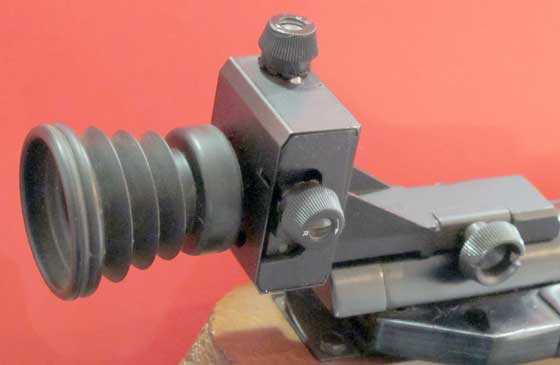
This Gamo peep is mounted on a Gamo 126 target rifle. It was also mounted on several other lower-priced target rifles like the Daisy 853. It is a basic target peep that is very good.
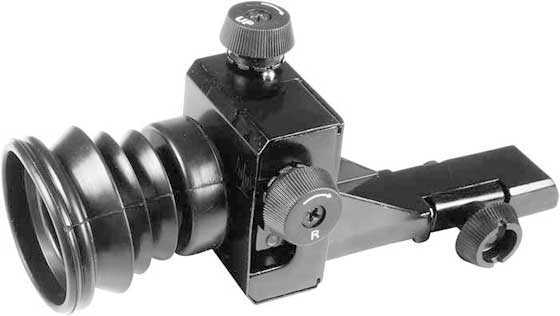
Air Venturi’s peep sight is one of many of the same Gamo design.
Daisy plastic peep
Okay, I am now dropping to the bottom of the barrel for target peeps. For decades Daisy has offered a 5899 peep sight for airguns like their 853 and even for the 499. It is a good workable peep, but it’s made mostly of plastic parts and this one has slop. How much slop varies from sight to sight and also with how much each sight has been used. They become looser the more they are used.
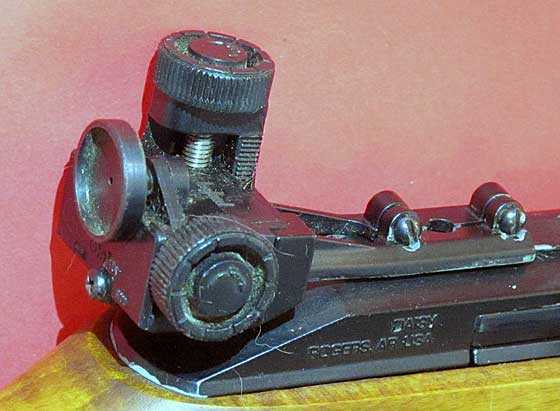
Daisy’s plastic peep works well if you know it’s foibles.
After you adjust one of these sights you need to shoot a group to see where the sight really went. And, when you reverse directions — going from a right adjustment to a left adjustment, you will often have to adjust as many as three clicks just to get the slop out of the mechanism and get the sight ready to move in the other direction. Shooters who have their own rifles get used to this and soon make good adjustments the first time they try. But coaches of teams that have many rifles can become confused when going from sight to sight. And coaches often make the sight adjustments for the newer shooters.
People have said the same thing about the Gamo sight — that is has slop, but in my limited experience it doesn’t have as much, if any at all. If these sights are mounted on an air rifle that is reasonably accurate you can get the sight dialed in very well. My recent test of the Gamo 126 demonstrated that. But if the rifle isn’t that accurate it will take longer to adjust the sight, since it’s never clear exactly where the rifle is shooting.
Summary
We have looked at high-grade target peeps today and we’re still not done looking at peep sights. There are still oddities to see, like the sight on a Daisy Number 25 pump BB gun, and perhaps the tube peeps that have been outlawed for international competition. Reader Kevin knows a lot about them as he has or has had several. What about the peep sights used by Buffalo hunters? Then there are Zimmerstutzen sights and BSF air rifle peeps the size of satellite dishes. I might even throw in some cheap peeps found on vintage .22 rifles, just for fun. I think there is still more ground to cover.

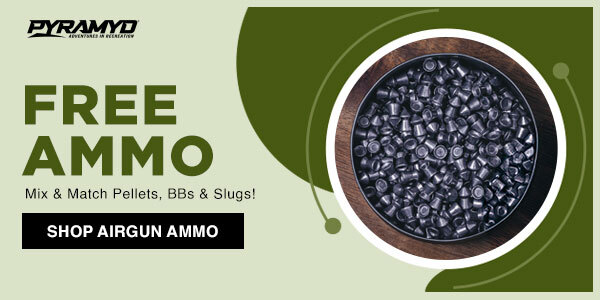
B.B.,
I’ve always favored using peep sights on springers. No broken reticles or lenses. When I was in my late teens I recall competing in metallic silhouette using a locally manufactured target peep sight mounted on a CO2 rifle against scoped rifles and still managed to place in the top half.
Your closing paragraph leads into a deep hole. If I recall the tube peeps were previously discussed and shown by Kevin and were outlawed in competition due to the magnification of the target, making them virtually scopes. Buffalo hunters had their tang mounted sights. What was the purpose of those satellite dish sized eyepieces? Yes, more on those odd peep sights that manufacturers made for the lowest cost. Maybe a modern day manufacturer/designer might be inspired to make one available to their line of rifles?
Siraniko
Siraniko,
Inspiration is what I’m going for on this one! 😉
B.B.
Siraniko,
I’m guessing the the purpose of those satellite dish sized eyepieces was to act as a blind, so shooters could keep both eyes open.
Bob,
You are correct. The old buffalo hunters used a wide leather flap around the peep for that.
B.B.
BB,
A fascinating article. I look forwards to learning more. You mentioned the 499, which I have. Yes, the knobs do have some play. The do click positively, but after the click, there is some play. It is possible to tension the threads one way or the other,.. but not sure it the tension would hold. I will have to play with it a bit.
Chris
BB,
Will PA remain open during this “shutdown” for non-essential business in Ohio? It started today (3/24) until 4/6,.. at this time.
If they do,.. would this affect the blog?
Chris
Chris,
Pyramyd AIR has been allowed to remain open and right now their orders are at the level of the Christmas rush. Ohio has declared them an essential business.
If PA were to shut down I think IT can run from home and I am already working there. I intend continuing as long as I can. 🙂
B.B.
BB,
Well,… that is good to hear. I imagine that they had to really get really “creative” for justifying staying open, to the State.
“Poor people will need to hunt for their food”.
“If people can’t shoot their airguns,… they will be shooting their firearms a lot more. Do you really want that?”
Hey,… whatever works! 😉
Chris
Chris,
No. They sell to the Government, among other things.
B.B.
Don’t forget the priority of keeping the squirrel and RidgeRunner’s feral aluminum can population in check. In fact, I think I see a can out in the back now. Probably from RR’s over-populated land :).
Fred formerly of the DPRoNJ now Happily in the Monsoon State of GA
Fred,
Are you trying to tell us it is a little wet down there? Maybe that can floated in from Chris’.
it was raining tarantulas here today. I think the squirrels and that can have drowned. More rain tonight.
Fred formerly of the DPRoNJ now Happily in the Monsoon State of GA
FYI,
I saw the Barra lever action at Walmart yesterday. I picked the box up and it had some heft. I did not get it, but might later. I should have. Yesterday was a mad rush to get (more) stuff. After 3 weeks, I finally did get a 20 pack of TP. This was around 1 PM. The store opens (now) at 7am. Yesterday was the 1st day of limits and there was only 8 packs of what I bought left. That’s all. All the rest, regardless of brand or size pack was gone. This is one of the bigger Walmart’s too with full food and now even a big gas station. Oddly, a quick final stop at a Dollar Tree was better stocked on some stuff,…. so don’t overlook the smaller stores. People are hitting the BIG stores first.
I asked the cashier about this. She said it was full this am. Before? I asked,….. “It was full and would be emptied in ((1/2 hr.)) until the next day”. That is ridiculous!!!!! and there is a “special place” for people that leave nothing for anyone else,… especially when it was there daily. The rest of the store looked (apocalyptic) in some areas. Some people had a blank look of disbelief in their eyes.
Get what you need now folks, if you can. Figure on 2-4 weeks. Sure,… you are still allowed to go out and get groceries everyday,…. but ask yourself,….. do you really want to expose yourself?
Be safe all,………. Chris
BB,
I too would recommend the AirForce rear peep sight to anyone wanting/needing a world class sight. The aperture disk is plastic, but you can replace it with a Gehmann, etc.
Their front sight though leaves a bit to be desired. It is way too proprietary. I believe it is 19mm. The standards are 18mm for the old ones and 22mm for the newer ones. The only source for irises to fit is AirForce. They used to offer three iris sizes, but now they only offer one.
I do know someone who made an adapter for his Edge and mounted an 18mm adjustable iris to it.
Want to embarrass someone who uses a large scope on his airgun? Stick several popsicles into the ground, from 4 to 15 meters distance. See what is better to hit them, the scoped rifle or a simple airgun with open or aperture sights sitting close to the barrel. The scope needs you to do a lot of ballistic calculations on the short distances.
B.B.
Good article! Peep sights are on interesting subject not often talked about. I just wish that the current Euro sights were not so expensive…
-Y
Yogi,
Forget those folks over there. Contact AirForce or at least PA and pick up a rear peep. Just because those Europeans charge more for theirs does not mean theirs is better. Just look at FX.
You can use them with a front post just fine.
Siranako ,
I agree with You on the peep sights on a springer . I just can’t wrap my mind around why people are so scope crazy on a gun shot from 10 to 30 yards !! . Most definitely avoids all the issues of springers such as harsh recoil and droop . I have them on 2 of my personal springers and naturally on my AR15 and my old 8mm Mauser has Lyman 57 sights . They are also the fastest sight on target for flash shooting .
Gene
BB,
Thanks for your article. I quite enjoy reading your blog—it is my favorite!!
I just purchased a Crosman 1322 (since there was a decent price drop and I’m still looking for a fun and reasonably accurate 35-50 feet plinker—something like the Buck Mark URX, but better accuracy and better trigger. I have and love the P17 save for the cocking effort) and it has a peep sight! I’ve not used it since I don’t want to unscrew the sight to flip it around to set it up and lose the current and accurate settings. Any advice on retaining the current settings, keeping in mind that I’m a complete beginner?
Thanks,
AP
AP,
I would not advise using that peep sight unless your pistol also has a stock. The key with a peep is getting close enough to it. Stick with the open sights, I think.
B.B.
Thanks, B.B.!!! Looks like I missed one of the fundamentals of using peep sights!!
AP
MisterAP,
You have a great “fun gun” in that 1322; yet, as B.B. has said, that peep is intended to be used with a shoulder stock. I had one 1322, but a second one came up at a price I could not resist; so I bought the shoulder stock to make a nice carbine for teaching kids to shoot. However, it turned out to be a “dave fave”! I love to shoot this thing. I wrap my front finger of my off-hand around the forearm (be sure to keep it below the pump tube!). Since you have more than one pistol, this mini-carbine might be of interest to you. This thing is just too much fun! Two mods I made since this picture were that I cut 2″ off the stock to shorten the length-of-pull, and I took a file to the front sight (it’s plastic and VERY easy to cut; so don’t overdo it =>) to thin it down to work better with the peep sight at longer ranges. My 2 cents.
Take care & happy shooting to you,
dave
BB, the Gamo site works great on my IZH60. I am not normally a fan of aperture sights but I just use the IZH60 in the shop with plenty of light. The reason I don’t normally like the aperture sights is that I normally shoot at small targets at 35 yards to about 50 yards in the woods and normally the sun is in my face. That combination is just not what aperture sights were made for. It is tough enough with a scope.
David Enoch
David,
Yeah — peep sights are not for field target!
B.B.
There are many peep sights on the used market that were originally made for .22RF rifles that can be mounted on air rifles with grooved receivers, or that have been drilled and tapped but the original sight is missing. However, some may require diffrent ht .front sights,You also have to know the spacing on the holes for the ones that are drilled and tapped. Examples of the ones that fit on the grooved rifles would be the Redfield RE -22, Browning peep from the Browning T-22 bolt action (,the old one), and some of the Williams Guide sights for RF,22’s. The Williams sights are probably the most common and available on the used market. But note , they are all screw adjust elevation /windage adjustments for the most part ,as are the Redfield one I mentioned above. Williams did not put target knobs on any peep sight until the early 1990’s, or maybe late 80’s Sights that have the same hole spacing for drilled and tapped rifles like the Crosman 160 for instance are ,based on my own experience, are the Mossberg #S331, and #S330 (which just had a longer arm to put the sight closer to your eye, but was the same otherwise), (the fold to the side) Mossberg S130,and Lyman 57 M.
BB,
Would spring tensioning the knobs on something like the 499 peep sight help with any play? I figure that would keep constant tension on the adjustments. Also, it looks like the knobs could be replaced with longer screws and then a lock nut (against sight body) could be employed. What think you?
Chris
Chris,
The knobs do have spring-loaded ball bearing detents. But steel balls in plastic knobs quickly wear them loose.
B.B.
B.B.
When using a peep or aperture sight, do shooters make adjustments during a course of fire
in a match? I have never used this type of sight. With a scope, you can see the strike of the round
usually, and make adjustments to the optic or compensate. And is a spotting scope allowed? Are spotters used?
It’s just if I cant see where the poi is then Its about being consistent with breathing and trigger control, and then checking the target after shooting, and making adjustments. Those little holes are so tiny. I like how Iron sights are
are the fastest way to get on target, tho.
Rob
Rob,
Not only is a spotting scope allowed, every 10-meter rifle shooter has one. It’s as much a part of their equipment as their custom-fitted shooting jacket. They use them during sight-in, which is a check that the rifle arrived at the match with the same perfect sight setting as before. I don’t know if you are allowed to look through it once the match has begun, but I would recommend never doing so! Seeing any shot that is not perfect would erode a shooter’s confidence.
As far as adjusting the sights, it isn’t done during a match — or it never should be done! The shooter at that point is a machine that is perfectly adjusted and the match is shot using the same steps for every shot. It is a mechanical drill. I never even move my feet once a pistol match has begun.
You said as much in your last paragraph.
B.B.
Yes, I’m a big fan of peep sights.
more
some more
Kevin
If you don’t feel like using any of those anymore. I know a few air guns that would be happy to wear them.
Just say’n. 🙂
Gunfun1,
I’ll keep that in mind. In the meantime, egun and ebay are good sources.
Kevin
I had a few Williams peep sights and with the adjustable iris. And the famous Gamo peep sight off and on my FWB 300 at different times.
Everytime I see the rear ones with the multiple adjustments reminds me of the eye doctor office.
That’s the ones I want to try. And interested in the magnified front sights.
I’m sure that’s getting close to low magnification scope shooting but would still like to try the peeps like that.
And I can only imagine how the filters work. Sounds alot like photography with the addition of pointing a projectile on target.
Yes, adjustable iris’s are almost infinite in their potential options and do work a lot like our eyes do. Those with polarizing filters remind me of the options we have with shooting glasses that come with a variety of lenses like my RE Ranger shooting glasses. They allow me to adapt to almost any light condition.
Adjustable iris’s usually allow changing the aperture opening, can come with filters and can come with magnification like the Gehmann you see in the box in one of my pictures above.
Magnification for your front sights, Eagle Eye’s, are also beneficial at times. You can see an eagle eye in the third photo next to the front sight inserts. The AOS microsight, shown in one of my pictures above, fits between your adjustable iris and the rear diopter sight and allows the front sight and target to be in focus together. Lots of options that fit almost any shooting situation.
noticed that the AOS Microsight isn’t shown in any of my pictures above. Here’s a picture of it:
Kevin
Can the AOS micro sight still be bought new?
And does it do what its suppose to without additional set up?
Yes, you can buy the microsight new. AOS was the first to bring the microsight to market but is no longer producing them. There are microsights that insert into existing iron peep sights, like those used in service rifle competition and now approved by CMP and there are also microsights that screw in between the rear diopter sights and your iris like B.B. is talking about today.
Here’s where you can buy the screw in microsight like I have:
http://www.champchoice.com/store/main.aspx?p=ItemDetailOptions&item=560
Here’s a good article on the non screw in microsight but the screw in microsight does the same thing and is made by the same company:
http://bulletin.accurateshooter.com/2011/01/creedmoor-sports-has-first-ever-micro-sight-for-service-rifles/
Kevin
Thanks for the links. I book marked them both.
Here’s the AOS Microsight mounted on the rear diopter of my LG 55 Spezial in a tyrolean stock:
Kevin
Nice! Nice! Nice!
Now we got to get BB explaining that stuff on his next report on peep sights.
I think I wet my pants.
Kevin,
You clearly need to find a 12 Step program!!! 😉
Chris
Seriously.
Whoa, Dude!
A lot of those sights really do need to retire to RRHFWA. Although it is true that most of the ladies here would not accept any of those peeps, it would be nice to have one or two in case a lady shows up who would like to change her outfit.
My Avanti 853 came with the Gamo style peeps. After a year or so I purchased a Gehmann rear sight so I could make use of the different filters for different contrast lighting conditions.
I agree that the Gamo was pretty decent…I didn’t notice that much of an accuracy improvement with the Gehmann (admittedly I think it cost more than the rifle itself), but in poorly lit venues the different contrast filters made shooting so much easier on these old eyes.
CSD,
Good to hear from you, man!
B.B.
B.B.,
Thanks for that section on sloppy peeps! I had a Winchester 94 .30-30 that was my woods gun in Florida. On the front, I had an Ashley Outdoor Express ramp with a white line down the center (fantastic sight, even in dim light); and the rear was tapped for a Williams receiver (peep) sight. I have used several of them over the years, but the one on that rifle was really sloppy, especially on the windage adjustment! Even worse than that, you could wiggle the sight from side to side. So once I had it adjusted to shoot point-of-aim with my preferred ammunition, I actually used Loctite on the rear peep. *shrugs* It worked fine for years; and I don’t believe the LEO to whom I later gifted it has ever had to change the sights. Come to think of it; the peep sights on my Sheridan haven’t been adjusted in over 15 years, and they still shoot perfectly…peep sights rock! =>
Loving this series & looking forward to the rest,
dave
Tube sights B.B. refers to in today’s article:
few more
and even more
Here’s a close up of the smallest scope I’ve ever owned:
Those of us from a machining background would categorize slop as backlash. One of the first things I learned in trade school was how to eliminate backlash error in machines like lathes and mills. For example, if you are turning a piece in a lathe, you always back the tool away from the cut and then dial it back in so as to always have pressure against the threads in the same direction.
Geo
George,
Yes, that is the solution to the Daisy sight, too.
B.B.
Geo,
You’re bringing back serious memories, man! Back in my 20s, as a young engineer, I would draw prototypes to be made by our machinist. Once day, he pulled me aside, and said I should learn how to use a vertical milling machine; after a couple of hours of instruction, he gave me one of my own prints, and asked me to machine the part; I said it was not possible as drawn; he said that was the point, and to use my new-found knowledge to draw prints while keeping in mind the actual machining operations required to do what I drew. Fast forward several years; I’m working for a small microwave shop in NYC; all the engineers give their sketches for prototypes to Carmen, the foreman who runs the machine shop. The first time I gave him a sketch, he looked at it, and he’s like, “What the heck? Who taught you to draw like this? Did you actually take drafting in college? NONE of the engineers here know how to make decent drawings! Everything they send me gets re-drawn by ME before I even give it to any of my guys. But I can give your drawing to them ‘as is.’ So again, I ask you; how did you learn to do this?” Then I told him about my model-maker machinist friend, Ed, and what he taught me, how to use a vertical miller and a lathe. He looked at me for a few seconds, then said, “Your friend did you a SERIOUS favor. I think you’re too young to even appreciate what he did for you; you should call him up and THANK him for what he did.” And I did that!
Thanks again for the memories,
dave
Dave,
Great story! Being more on the machinist-ish end of your story,…. it is truly amazing to the amount of disconnect that often exist between the designers and the people that actually do the work.
Chris
Chris, you got it, man! In my case, due to being young and not experienced with machine tools, I was drawing sharp corners in places where is was not possible to machine them, and where the design could easily live with a 1/4″ radius anyway. I lived, I learned…thanks to my machinist friend! =>
Dave,
It brought back some memories for me also. When I went to trade school I graduated as a machine technician. I had to take 3 months of drafting but luckily I wasn’t required to make my drawings in ink like some of my friends who were taking tool and die drafting. Those drawings were works of art. I had to take 3 months of electronics too. Then hundreds of hours on lathes, mills, grinders, etc. There was no such thing as CNC yet. The machines were all World War II surplus but we did some very precision work on them.
Draftsmen did not have any experience with machining so they would specify ridiculous tolerances on their drawings. My friend worked in the toolroom and all he had was a Bridgeport mill and lathes. The engineers would send him drawings with hole location tolerances of +/- .0005″. They didn’t know the difference between a Bridgeport mill and a jigbore. You fortunately learned this early in your career.
Geo
Geo791,
This a peep Sight blog but that is what causes so many of the problems folks have with their scopes as well. I remember being taught when torquing to back off 1/4 to 1/2 turn to get proper reading. It was explained that static electricity generated by the surfaces sliding past each other caused improper torque values. This is the closest i could find on the Internet to what i was taught five + decades ago: https://www.marshfasteners.com/best-way-check-torque-value-bolt/
springs in scopes are a combination of the spring, friction as well as the static which eventually discarges.
shootski
Shootski,
“….. ,friction as well as the static which eventually discharges.”
Now that is splitting some mighty fine frog hairs there!!! I love it! 😉
Chris
Shootski,
I will say that I have never heard of the technique you describe to “back off 1/4 to 1/2 turn”. I don’t know where in the world that idea came from, but it sounds ludicrous. Static electricity affecting torque values is also nonsense.
I worked at Parker Hannifin Hydraulics for 43 years, 40 of which were in quality assurance. One of my responsibilities was to calibrate all of the torque wrenches in the plant. All of our torque wrenches were of the click-type. I used a machine designed to calibrate torque wrenches. We checked them at 60%, 80%, and 100% of the range. The spec was +/- 4% as I recall. The wrenches ranged from 200 in lbs to 400 ft lbs. The company tried several different brands of wrenches but the only ones that held calibration consistently within spec were Snap-On. If a Snap-On wrench was out of spec we sent it back to the factory for repair. All the other wrenches were scrapped out.
I read the information at the link you posted. I have to assume they were referring to beam style wrenches, which by design are not very accurate. You should never loosen a bolt with a click style wrench because it destroys the calibration. We instructed the machine operators to NOT use the torque wrenches as breaker bars, but they continued to do it anyway and destroyed many wrenches. Some believe that because the click style torque wrench have a reverse switch, like a ratchet, that is intended to loosen fasteners…it is not. The reverse is intended to be used to torque left hand threaded fasteners.
Also, lubrication on the threads will affect the torque accuracy. That is the reason you may see two different torque specs, one for lubed threads and one for non-lubed threads.
Hear is a pet peeve I have. It is very important that wheel lug nuts on vehicles are torqued correctly, and to the proper specification to avoid warping the rotors. Virtually no body does this correctly. Bell Tire probably comes closest because they do actually use a torque wrench. Whenever I have my tires rotated, the first thing I do is loosen all the lug nuts and re-torque them with my Snap-On wrench. You would not believe how far off I have found them, even from the dealerships.
Geo
Geo: I affirm and second your comment on wheel lug torque. I check them at home if a garage rotates my tires. I also use light oil on the treads, just a single drop to inhibit corrosion, but never on the taper of the wheel lug. Never had a loose lug nut ever, but also never had one seize due to a rusted stud.
My late father would always kid me about being picky about wheel lug torque and air pressures. He’d come visit and I’d go after his car. Tire pressures were all over the place as was, correspondingly, tire wear. I’d air them up and double check with my dial pressure gauge and torque all the lug nuts. It’s amazing how some wheels even stay on some vehicles.
Doing work on bicycles to help out at my LBS (Local Bike Shop) always involves taking things apart, greasing the threads and putting things back together. Partly because few people ever move a fastener and rust “worms” get in the fitments if they are not greased. The other reason is getting a better, truer torque on the fastener without having to over-tighten pieces.
Geo,
I have no problem with anything you have written.
I understand exactly where you are coming from!
I am just as bad about personally retorquing my lug bolts/nuts on land vehicles and the flying ones.
You however were raised in the territory of hundreds of inch or foot/lbs! I have worked with those kind of values but the values I lived in were much smaller! My work was done in an Avionics Shop/Department and our torque values were typically from 10 Inch/lbs downward toward zero.
http://physics.bu.edu/~redner/211-sp06/class05/static.html
The above link sort of explains the Physics issue we faced with instrument and ultra high speed 2″ video recording head repair.
shootski
B.B.,
Very interesting article.
“The target peep only needs a narrow range of elevation adjustment, because the distance is always the same — 10 meters for air rifles and 50 feet for smallbore rimfire target rifles.” Shouldn’t that be 50 meters instead of 50 feet, assuming you had ISSF prone and 3 position in mind?
That sliding vertical post on the AirForce peep is a great idea!
Do you know of any supplier of front sight inserts for the FWB300? I would like to swap out the ring for a post when plinking. Unfortunately Weihrauch front sight inserts are a different size and don’t fit the FWB.
What’s your opinion of the Williams FP-AG-TK peep? (pictured).
Bob Ryan,
NRA Small bore can be shot at 50′
Olympic rifle is shot at 50 meter.
shootski
Bob,
I was referring to the old style of NRA competition — not international. But the relationship remains the same.
Have you checked with TW Chambers Airgun Spares?
B.B.
Bob Ryan,
Regarding swapping out your ring for a post in the front globe sight on your FWB 300 be aware that Feinwerkbau has installed a variety of globe sights on their airguns over the years. If your globe sight is original it is an M18 (18mm OD of the globe sight). The OD (Outer Diameter) of your site insert will either be 17.2mm, .676″ or it will be a 16mm. Measure the OD of your current sight insert, ignoring the ears, to determine which one you need.
All manufacturers, i.e., Walther, Anschutz, Weihrauch, Diana, FWB, etc. created their own front globe sights and are proprietary ESPECIALLY on how the “ears” on the outer sides of the inserts line up with the globe sight. This isn’t a problem if you want to try clear inserts since they don’t have ears that need to line up and are merely a pressure fit by screwing your globe sight tight against them. Metal inserts, like the post you seek, needs to be an FWB or if it’s another manufacturer’s the ears on the insert will need to be modified.
In your search for a metal post style insert there are two links below that should be able to help. First you need to determine which OD of insert you need then you need to determine the height of the post you prefer. I’ve dealt with both of these folks. Good people. Nikkonos in Canada is especially knowledgable so don’t hesitate to email him with questions.
http://www.ebaystores.com/Olympic-Marksman-Equipment/_i.html?rt=nc&_sid=53339476&_trksid=p4634.c0.m14.l1513&_pgn=1
http://www.champchoice.com/store/main.aspx?p=FullIndex
I have a number of the Williams Target Knob Peeps. They all work great, especially if you pop for the extra bucks and also pair them with a Merit (Adjustable) Disc – an adjustable aperture. The WPS have a tightening screw to increase the load on the dovetail so that once a set is found, a slight, very slight tightening willt prevent any wiggle whatsoever of the elevation. Just remember to very, very slightly loosen the jamming screw before adjusting with the target knob. Not much preload is necessary or helpful; one learns this by careful experimentation – in fact, once you learn the sight you can find that Goldilocks torque on the thing that’s not too tight and not to loose but just right to allow adjustments with virtually no wiggle.
One thing I have learned, the expensive way, is to measure the height of the top of the front post to the plane of the top of the barrel (and on a springer the compression tube) and use customer service at Williams Gunsight Company to instruct your whether to order a high sight line or low. I ordered a low sight when I should have ordered the high line because I didn’t account for this post height.
I did find out that I could order the high sight line gunsight without the target knobs and install the target knob parts from my low line making it making a very functional hybrid. It would have been cheaper to have gotten the high line rather than the low line from the very start. Avoid my error and ask the customer service people which height sight to get to start with.
Hint: An RWS rifle probably takes the high line. Don’t assume. Ask! Learn from MY mistake.
Guys,
off topic here. The trigger on one of my Benjamin Marauder air rifles just broke at the lever off the rear of the trigger, the part that contains the set screws. Any recommendations for a replacement or should I just go to Crosman and order one? Pyramyd AIR is out of stock so I guess this trigger has a problem?
If anyone has replaced these before, do I have to open the trigger assembly to do the replacement?
Fred formerly of the DPRoNJ now Happily in the Great State of GA
Fred,
While not sure,… I think that was a Gen. 1 issue. I do remember reading it here,… somewhere,… at sometime,… I think? 😉
🙂 Chris
Fred DPRoNJ,
You may want to check this for answers:
http://www.marauderairrifle.com/forum/index.php
Gen I or II IS the first question. Then which part is actually broken? you will need to open the side plate if replacing the actual broken part. you could also replace the entire trigger group without opening it. That is the most expensive option.
Crosman parts is just a call away; you must have the part number(s)
Good Luck,
shootski
Fred,
Yes you do have to open the trigger assembly, but it is no big deal, it opens easily and the parts do not fly out. B.B. had a broken one here /blog/2016/11/generation-2-25-caliber-benjamin-marauder-part-9/
I do not know if there is any difference between the gen 1 and 2 trigger blade, Crosman part number 1763-042 and the lost set screw from the point of break is 1763-054, double check on those numbers, but that should get you back in business.
Mike
Thank you, Shootski, Chris and Mike. I had independently gotten the part numbers from the Crosman site. I didn’t remember reading that blog where BB’s re-tuned Marauder had suffered a broken trigger but the part and break are identical. I still have the set screws so no biggy there. I’ll do a little more exploring on the Marauder forum and perhaps the Yellow to see if there are any recommendations for an upgraded part rather than what looks like this sintered metal trigger in the rifle. My model is BP2263 so maybe its a 2nd Gen?)but I’ll double check that, too. The key is if Crosman has revised the part so it’s a bit stronger.
Thanks all
Fred formerly of the DPRoNJ now happily in waterlogged GA
Fred,
We hope the rain will stop soon, may or may not, welcome to Ga. Massive wetness is not unexpected at this time.
Mike
Fred,
I had forgotten that broken trigger completely, but after reading that report it seems I suffered your problem as well. From the little I said it seems the trigger blade replacement isn’t that difficult.
B.B.
Tom, a great article! Being a target rifle fan, I’ve become a peep sight fan over the years. My stash is not up to the level of Kevin’s but I do have a few “extras,” LOL.
One thing I would point out is that many match-grade peep sights use the same thread (9.5 x 1.0 mm) for the eye disk; the Germans standardized this back in the 1950’s I think. This means that accessories for these sights are interchangeable between brands; Weihrauch, Anschutz, FWB, Walther, AirForce, and others use this thread (but not Haenel unfortunately, which seemed more influenced by the classic English Parker-Hale sights).
Gehmann, Centra, and AHG Anschutz make a truly astonishing array of goodies for rear sights. To me an adjustable iris to adjust to varying light conditions is a must (most OEM disks have an opening around 1.0 mm which is great for a well-lit target range, but not much else). The irises made by these companies are modular; the basic iris can “stack” on colored filters, a polarizer, and a 1.5x magnifying lens, in literally any combination of some or all of these features. A tour through Gehmann’s site is a treat!
https://gehmann.com/english/products.php?kategorie=20
I would also mention that my favorite brand of older match diopter sights is Anschutz. They have an 11 mm rail spacing that is widely used, and their flexible base has tremendous clamping power and will adapt to minor variations in rail spacing. I love them on post-1978 Weihrauch, and Diana, guns in particular (Walther, FWB, and older HW’s have different rail spacing partial only to OEM sights, though). A wide variety of models was made and they are relatively easy to find these days.
Last but not least, I heartily echo your comments on the AirForce sight – an unbelievable piece of plunder for the money! It is also designed for 11 mm rails.
Mike,
Thanks for commenting. You and Kevin are helping me with Part 3.A lot of people think I know everything, or a whole bunch of stuff, and maybe I have picked up a few things along the way, but I had to research this subject like most people and I am learning as much as anyone. What a job! 🙂
B.B.
For what it’s worth, one of my favorites…an HW 55 MM, with an Anschutz “Universal” diopter sight, and Gehmann magnifying iris – all of mid-1970’s vintage, and scrounged from airgun shows and auction sites.
Evening all. I must admit that the Haenel 311 is a favourite of mine! Its as quirky as the diopter that sits on top of it but, for me, it works well and does everything I ask of it. I have achieved accuracy approaching HW55/ Walther LGV levels and considering its trigger and velocity are inferior, thats pretty damn decent in my book. Pistol weight RWS match pellets are its favourites.
Regards from Bonnie Scotland.
B.B.
The Air Arms T200 Sporter Air Rifle is sold with what appears to be a peep sight. What do you think of this one? Where would you place it in the range of peep sights from high grade target peeps to sloppy peeps?
Cstoehr,
I’m not B.B. but to answer your question the rear diopter/peep sight on the Air Arms T200 Sporter Air Rifle is a Gamo/Air Venturi. You can read about B.B.’s opinion of this sight in the article at the top of this page. For what it’s worth the pressure gauge on my Air Arms T200 Sporter Air Rifle was also an Air Venturi (Daisy) product.
BB,
did you know that Weihrauch offers a peep sight for its airguns?
Mel,
Yes, I know that. I have had several. Unless there is something new that I haven’t heard about?
B.B.